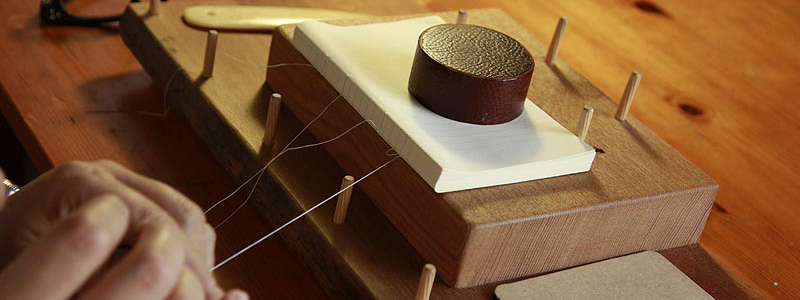Related terms
This glossary of leather and book-binding related terms.
Vegetable tanned leather
Vegetable tanned leather is tanned using natural tannin found in tree bark or vegetables.
Vegetable tanning is traditional tanning method and requires a fair amount of time in the tanning process.
At least, 40 days are actually needed to transform raw hides into vegetable tanned leathers.
Vegetable tanned leather is very tough ,but not stable in water.
Vegetable tanning need no chemicals that cause natural pollution and it is nature-friendly tanning method.
In our notebooks, Vegetable tanned leathers are used as row material.
Leather-bound notebooks with vegetable tanned leather: Record 216, Record 288, Record 336, LP Record
Chrome tanned leather
Chrome tanned leather is tanned using salts of chromium.
Now, most of leathers in the marketplace are chrome tanned leather.
It is more supple and pliable than vegetable tanned leather.
Tanning process of chrome tanning are finished in a relatively short period of time.
Chrome tanned leather provide better cost performance than vegetable tanned leather.
But salts of chromium that used in the tanning process may cause natural pollution.
Toscana Leather
"Toscana" is the product name of "I.P. Valdarno International" in Italy.
"I.P. Valdarno International" is an associated tannery of Genuine Italian Vegetable-Tanned Leather Consortium.
"Toscana leather" is a kind of vegetable tanned cow hide and it has beautiful leather texture.
It was given plenty of oil and it is a kind of oiled leather too.
Leather-bound notebooks with "Toscana" leather: Record 288, LP Record
Goatskin
Tanned goatskin is very soft and tough.
It is often used for rugs, carpet, gloves, boots, and book binding.
Famous production areas are around India(India, Bangladesh and Pakistan etc.).
We use the goatskin from Pakistan and it is vegetable tanned goatskin.
Tomoe River
Product name of paper which we use in all of our leather-bound notebooks.
"Tomoe River" was developed as paper for printing by Tomoegawa Co,. Ltd.
Original "Tomoe River" is very thin and lightweight, So it is suitable for catalogs mailed to customers.
Then "Tomoe River" for writing was developed.
As thickness and weight are key factors in Japanese market, "Tomoe River" are used in small journals now.
"Hobonichi Diary" which has used "Tomoe River" is very popular in Japan.
"Tomoe River" has a high reputation in Japan, Especially among fountain pen lovers.
Leather-bound notebooks using "Tomoe River": Model 216, Model 288, Model 336, LP Record
Papillon Toji(Papillon sewing)
"Papillon Toji" is a process of bookbinding which the book designer Ms. Kumiko Tochiori developed in Japan.
It is a method of sewing together "signatures", or folded and gathered papers.
In our notebooks, a "signature" is made by 6 sheet of paper which are folded.
All signatures are sewn through the folds of individual signatures by hand and the book block(gathered signatures) is built.
For example, Model 216 is made by 9 signatures.(a signature = 6 sheet of paper folded = 24 pages )
"Papillon Toji" have roots in Japanese traditional bookbinding method, or "Yamato Toji".
It is a fusion of European bookbinding and Japanese traditional bookbinding.
This method makes a strong book that will never come apart and allows the book to open flat.
Leather-bound notebooks by "Papillon Toji": Model 216, Model 288, Model 336, LP Record
Tips
For using our notebooks better.
To replace a bookmark
Our leather-bound notebooks are designed to ease replacing the bookmark ribbon.
The bookmark ribbon just pass through two holes on the spine of a notebook.
The bookmark ribbon is unfixed. So, It is easy to replace it.
To replace an elastic-closure
Model 288 is designed to ease replacing the elastic-closure.
At first, remove the old elastic-closure.
Pass a new elastic-closure through holes on the cover and make a knot on the inside of cover.
Tips for long-term storage
If you start to store our leather-bound notebook for many decades, remove the bookmark and the elastic-closure to prevent little influence of acid.
If you tucked a piece of paper into the notebook, remove it also.
